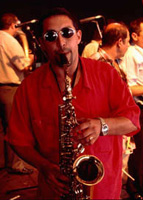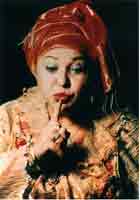




|

When the Road Bends...
tales of a Gypsy Caravan
 |
a concert film with stories as rich as the music
A foot-tapping journey into Romani music, roots and life.
Shot by Albert Maysles, a musical documentary feature by Little Dust Productions in collaboration with
ITVS, Fortissimo Films and FuWorks. Concerts produced by World Music Institute.
Visit the new film website:
www.GypsyCaravanMovie.com
"You cannot walk straight
When the Road Bends..."
- romani proverb
Genesis of Film:

In 1999 the first "Gypsy Caravan" tour presented America with musical ensembles from six countries. Forty
musicians came together as strangers but the chemistry and music grew between them on tour, forging a bond
that was magnetic for all to behold. They blended in a grand finale on stage, they shared a tour bus, and on
late nights in hotels across America they swapped stories and instruments from around the globe.
Foreign musicians spoke to each other easily in Romani, the language of Gypsies worldwide. They also spoke
with American Romani visitors and fans. They exchanged family tales and customs, musical tricks and plentiful
jokes. And yet their mutual knowledge of a shared culture and language also determined an internal kind of
caste system that soon carved out a clear hierarchy even amongst compatriots. Many onlookers remarked that
it was a criminal shame not to be making a film about this magical moment of unison.
Overwhelmed by positive response, the New York tour organizers, World Music Institute, decided to do it again and the Gypsy Caravan tour returned in Fall
2001 (with some groups from the last tour and a few new ones as well). This time we were ready with our cameras.
Director/producer Jasmine Dellal's last feature documentary, "AMERICAN GYPSY: a stranger in everybody's land",
told the tale of an American Romani man seeking justice for his honor and his people through the U.S. court
system. It was broadcast on American television (PBS's POV series) and won international acclaim, press attention
and festival awards, as well as being championed by many Romani people.
(For more details see: www.americangypsy.com).
WHEN THE ROAD BENDS... is a lyrical film, relying on visual and musical imagery to immerse us into new worlds.
There is no narration. Political conclusions are left for the audience to draw. We give them the beauty of
performing Gypsy musicians who are cheered by high-priced packed houses. And we also give them the contrast with,
for example, the mud huts of a Romanian village where Romani children cannot afford to get to school - or when
they do go to school they are routinely sent to classes for the mentally disabled. Performing for an audience of
thousands, we see an old man on stage singing a ballad. He drags his fingers along an intentionally broken string
on his violin, creating an eerie growl that hushes the crowd and then brings them to their feet with applause -
and then we meet the musician's family. They are in a stark shack beside the only road in a Romani village where
many people want to return to Ceaucescu's regime "because at least under communism EVERYONE was forced to work
so we couldn't be discriminated against when it came to employment." Most audiences will be enchanted by both
scenes because both the concert and the village are picturesque, but it will be enlightening to see them together
and learn that the musical Gypsies in New York are the same as the impoverished, politicized peasants of Europe.
"Roma Rule - Gypsy music is escaping its 'ghetto' in Romania to become a worldwide
sensation that some fans liken to the birth of jazz ...Gypsy music is stirring audiences around the
world. Top bands from Central Europe are playing upwards of
100 foreign gigs a year. Filmmakers are hungry for their scores. Critics have likened the outpouring
to the birth of jazz in the U.S. in the 1920s. Says Simon Broughton, co-editor of The Rough Guide to
World Music: 'The music does what music should do. It tears at your heartstrings and gets your blood
racing.' "
--TIME Magazine
Featured Artists:

MAHARAJA (Maharaja movie clip) is a group
which combines leading musician tribal castes from the desert of Rajasthan in northwest India. Maharaja has
performed at hundreds of concerts worldwide and dazzled audiences with an energetic hybrid of Indian music,
acrobatics and dance. Founded in 1995 (originally named 'Musafir'), this group gathers musicians, poets and
shamans who in Rajasthan would not play together, but here create an exciting fusion of North Indian folk,
classical, Arabic, sufi trance and crossover styles that create an eclectic aesthetic. On the first Gypsy
Caravan tour, they discovered the richness of flamenco and have since begun a side project, Maharaja Flamenca,
which performs on this tour with Antonio El Pipa.
ANTONIO EL PIPA FLAMENCO ENSEMBLE (Pipa movie clip) from Andalucia, Spain, is one of the most traditional flamenco groups performing today. Born
in Jerez, Antonio comes from a family dynasty of Gitano artists, among whom are his grandmother, the legendary
Tía Juana la del Pipa (now deceased) and his aunt Juana la del Pipa, who dances in this group and sings
with a gravelly voice that feels as raw as centuries of pain. Their 'Gypsy Passion' dance production brought
Antonio and his aunt Juana accolades from critics in the USA and Europe, and they continue to perform around the
world and to the toughest flamenco audiences - in Spain.
 ESMA REDZEPOVA (Esma movie clip) from Macedonia,
performed for more than 40 years and was called the musical "Queen of the Gypsies." Her impassioned voice
reduced audiences to tears, and got them dancing in the aisles. Esma was normally accompanied acoustically by the
accordion, clarinet, trumpet, tarabuka and double-bass. Esma was nominated
for a Nobel Peace Prize for her Rom-related political work. With her late husband she adopted 47 children and
trained them to earn a living with music. Her basement became home to a 24-hour Romani TV station reporting
on everything from new Romani pop hits or community birthdays, to Macedonia's 5,000 Romani refugees from Kosovo. Esma passed in 2016.
ESMA REDZEPOVA (Esma movie clip) from Macedonia,
performed for more than 40 years and was called the musical "Queen of the Gypsies." Her impassioned voice
reduced audiences to tears, and got them dancing in the aisles. Esma was normally accompanied acoustically by the
accordion, clarinet, trumpet, tarabuka and double-bass. Esma was nominated
for a Nobel Peace Prize for her Rom-related political work. With her late husband she adopted 47 children and
trained them to earn a living with music. Her basement became home to a 24-hour Romani TV station reporting
on everything from new Romani pop hits or community birthdays, to Macedonia's 5,000 Romani refugees from Kosovo. Esma passed in 2016.
FANFARE CIOCARLIA (Fanfare movie clip)
is an eleven-man brass and woodwind band that comes from the village of Zece Prajini, near the Romanian-Moldavian
border. Their music combines Romanian, Gypsy and Turkish influences, even elements of klezmer. The group's three
CDs have enjoyed huge success, and they have appeared on festival stages all over the world, as well as playing
on film soundtracks for artists such as Goran Bregovic and Emir Kusturica. "We're one of the last, and we're the
fastest of them all!" says the group's leader, Ioan Ivancea. Fanfare Ciocarlia truly deserves the title of the
fastest and perhaps the craziest of the Romani brass bands.
TARAF DE HAÏDOUKS (Taraf movie clip)
is a vibrant group of Romanian musicians whose repertoire includes Romanian wedding music, violin ballads and
accompaniments to jazz, classical and rock. They have performed with Yehudi Menuhin and the Kronos Quartet,
played a prominent part in Tony Gatliff's acclaimed film "Latcho Drom" and appeared alongside Johnny Depp in
Sally Potter's "The Man Who Cried." On stage, 12 musicians deftly pass back and forth musical creations that
appeal to a range of music lovers far beyond World Music and Fusion fans. But however strange their new found
fame may seem to themselves, their music stays true to itself, keeping a strange "edge", an undefinable charm.
It seems to be getting better with each concert and new album, and they elicit ever more
praise from the press. The oldest lead
violinist is 79, there are others in their 60s and 20s, playing cymbalum, accordion, flute and powerful lungs.
When Taraf return to their home village, the economy is boosted because modest concert earnings allow them to
put their children in school and buy a few local goods, which is enough to keep the village going until the
next tour paycheck. Clejani is a Romani village of musicians who were once in constant demand for weddings,
but dwindling tradition has taken its toll. Now international tours are the goal. Taraf de Haïdouks
(literally "band of brigands") is probably the best known of Gypsy musicians today.
Movie Clips:
PHOTO ALBUM:
CLICK ON PHOTO TO ENLARGE
PERFORMANCE
 |
 |
 |
 |
| Esma in concert | Flamenco dancing |
Maharaja dancer | Taraf's lead violinist |
| |
 |
 |
 |
| Taraf's Cacurica | Fanfare Ciocarlia
| Fanfare performance |
AT HOME
 |
 |
 |
 |
| Fanfare musicians | Fanfare junior
| Juana sings at church | Playing with camera |
Top of Page
|
Home
|
Films
|
Shop
|
About Us
|
Contact Us
|
News
|
Links
© Little Dust Productions, All Rights Reserved
|
Last Updated: January 2022
|
|
 |
|











